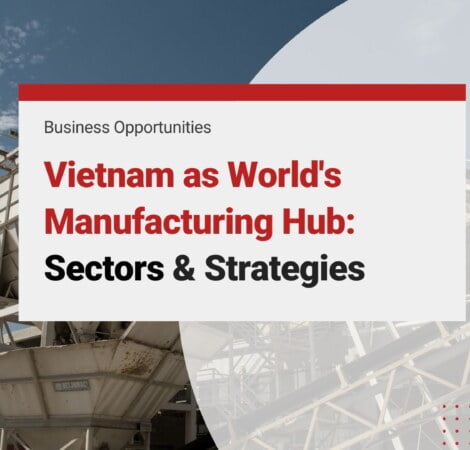In light of the US-China trade war, manufacturing businesses are looking for the next best option to set up their factories. Only a handful of economies like Vietnam have the infrastructure and human resources to provide such ground for shifting manufacturing destinations in Asia.
One of the fastest-growing economies, India, had been a promising candidate. However, according to Bloomberg, since 2014, the country recorded one of the worst worker participation rates anywhere in the world. On top of that, the government has signed no free trade agreements in its tenure of eight years and has yet to give much attention to improving its industrial policy.
Vietnam’s manufacturing landscape has witnessed remarkable growth and become a driving force behind the country’s economic development. With its strategic location, abundant resources, and skilled labor force, Vietnam has emerged as a top destination for manufacturers seeking to optimize costs and tap into a thriving market.
This article briefly overviews Vietnam’s manufacturing landscape, exploring its major industries, manufacturing hubs, and the factors that make it an attractive investment option. Understanding the importance of manufacturing in Vietnam is crucial for businesses looking to capitalize on the opportunities presented by this dynamic and rapidly evolving sector.
Vietnam or India: the world’s Next Manufacturing Hotspot
India is squandering a $28 trillion potential in global commerce by adopting a more nationalistic approach. This inward tendency stems from the notion that a 1.4 billion-people economy can be sustained only by internal demand.
Even before the Covid-19, only around 1% to 2% of India’s population could be classified as middle class, compared to 25% in China. Several well-known economists believe that the overall objective of a “self-reliant economy” is relatively tough to attain for India, according to Bloomberg News.
However, Vietnam is adopting the East Asian Tiger countries’ success formula: open and frictionless trade. The country is gaining a greater market share in international commerce than India, although having a fraction of the population.
“Made in Vietnam” – the Next Manufacturing Hub
Vietnam is popular for being a manufacturing center, particularly for higher-income countries pursuing the “China plus one” approach. This approach is a business strategy in which corporations diversify their investments outside of China to lessen their dependency.
Due to minimal overheads such as buildings, land, and labor, the cost of doing business in Vietnam is modest, primarily for manufacturing. It also includes progressive taxation rules for foreign businesses and rewards for businesses that use or intend to use green energy.
Vietnam has appropriate policies to encourage FDI and puts more emphasis on creating a liberal, impartial environment. It also fosters the assistance of other industries and deeper interaction with existing and future investors by creating the essential circumstances for efficient decentralization of FDI management.
Also, the most appealing quality of conducting business in Vietnam is location and accessibility. With 58.2% of FDI in 2020, Vietnam’s manufacturing and processing industry were the most popular — and for a good reason.
Related Reading: Vietnam Business Opportunities 2022
The country is strategically located, and it has exceptional access to key commerce and freight routes in and out of Southeast Asia and Asia, compared to most of its neighbors. It offers a plethora of international airports, seaports, and rail connections, all of which help with manufacturing and logistics.
Where to Invest – Vietnam as ‘Plus One’
84% of Vietnam’s energy needs are fulfilled from fossil fuels, signifying that there is a lot of room for investment in the renewable energy sector.
Vietnam has gained the reputation of a renewable-energy powerhouse across Southeast Asia, notwithstanding its dependence on fossil fuels, thanks to a mix of cheap tariffs and tax advantages. With more on the way, the country’s grand plan contains a financial component to help the country pivot to a more ecologically friendly path.
The region’s reliance on fossil fuels offers the way to a more sustainable supply mix, but the transition will be tough since it will require striking the right balance between expanding demand and cleaner energy supply without sparking inflation, eroding corporate profitability, or raising consumer costs, according to Carnegie Endowment.
Vietnam Gains Momentum in 2022
According to Fitch Ratings, Vietnam’s recovery from the crippling pandemic and subsequent lockdowns will accelerate in 2022 as domestic demand improves and export performance stays solid. With the recovery gaining traction, growth is predicted to rise to 7.9% in 2022, one of the highest in SEA.
Vietnam’s export sector is expected to remain robust this year, thanks to its cost competitiveness and key trade agreements in place. Moreover, trade analysts are optimistic that in 2022-2023, the export sector will continue its dominance and shall prove to be ground-breaking in catalyzing investments from foreign businesses.
Conclusion
In conclusion, Vietnam’s manufacturing landscape offers many opportunities for businesses seeking cost-effective production, skilled labor, and a favorable business environment. The major manufacturing industries, strategic hubs, and favorable cost comparisons with China make Vietnam an attractive destination for manufacturing investment. Chinese investment in Vietnam’s manufacturing sector further strengthens its growth trajectory. Understanding the driving forces behind the shift to Vietnam, including advantages in cost, trade agreements, political stability, and skilled labor availability, is crucial for businesses considering manufacturing relocation or expansion.
Moreover, Vietnam’s skilled labor force, infrastructure development, efficient supply chain management, and favorable tax incentives create a conducive environment for manufacturing success. Navigating the regulatory landscape and understanding the future prospects of Vietnam’s manufacturing industry are key considerations for businesses looking to establish or expand their operations.
As Vietnam continues to evolve as a manufacturing hub, embracing technological advancements and focusing on sustainability will be essential for long-term growth. By staying informed about emerging trends, challenges, and opportunities, businesses can position themselves for success in Vietnam’s dynamic manufacturing landscape.
By providing a comprehensive exploration of Vietnam’s manufacturing landscape, we aim to equip decision-makers with the necessary knowledge and insights to make informed choices regarding manufacturing investments in Vietnam.
